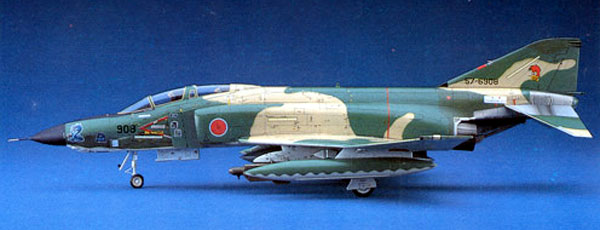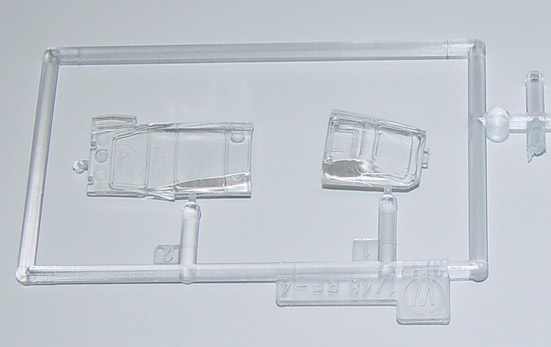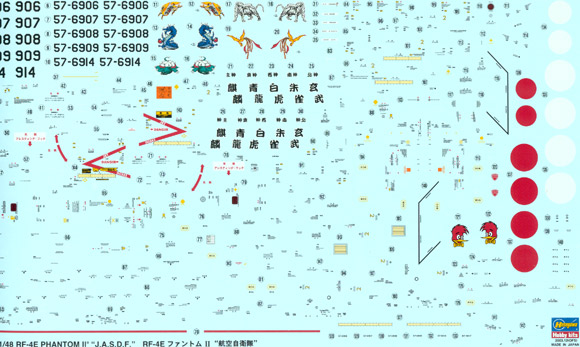|
JASDF RF-4E Phantom II

Hasegawa
S
u m m a r y
|
| Catalogue Number
and Description: |
PT-30 - JASDF RF-4E Phantom |
| Scale: |
1/48 |
| Price: |
3,200 yen |
| Contents and Media |
Injection molded plastic, |
| Review Type: |
FirstLook |
| Advantages: |
Full camera load. Interesting decals
|
| Disadvantages: |
Some parts with raised panel lines
due to mixing of old-tool and new-tool parts |
| Recommendation: |
Recommended |

Hasegawa's 1/48 scale RF-4E Phantom II will be available online from Squadron
Reviewed by Dave
Williams
For a number of years, Hasegawa has about had the 1/48 scale F-4 Phantom
market cornered with their detailed releases of Phantom versions from the F-4B
thru the F-4S, including the Spey-engined British F-4s. There has been one
notable exception in Hasegawa’s family however: the reconnaissance versions.
This oversight is now corrected with the new release of the new RF-4E kit in
markings of the Japanese Air Self-Defense Force.
Like many of the Hasegawa Phantoms, the kit is a mixture of new tool
type-specific sprues and sprues from previous F-4 kits. The new tool parts
include new fuselage halves, instrument panels, cameras, clear camera windows,
and a nice AN/ALQ-131 ECM pod. Parts reused from previous kits include the
canopy, remainder of the cockpit, landing gear, drop tanks (both the original
USN style and later F-15 high speed centerline tanks are included), wings from
the F-4EJ Kai kit, and other common F-4 bits. The majority of the kit features
recessed panel lines, however some of the old sprues retain raised panel lines.
Notable items with raised panel lines are the horizontal stabilizers, wing
tanks, and the curved inboard pylons used by this version. The non-slotted stabs
require the removal of the raised arrowhead stiffener, which will provide a good
excuse for rescribing these parts.

Click the thumbnails below to view
larger images:
Overall, the new parts look good and detail is on par with Hasegawa’s other
F-4 kits. The kit includes a complete set of camera to populate the nose
including a forward oblique KS-87B for camera station #1, a pair of side oblique
KS-87B cameras and vertical KA-56E for station #2 and a KA-91B camera for
station #3. The instructions show all five cameras installed in the nose,
however it is not clear that all of them would be carried simultaneously in real
life. To cater for the different types of reece noses, the underside of the nose
is molded separately in clear plastic.

This kit contains parts for the “rounded” nose only. Photoflash cartridge
bays are molded into the fuselage with the doors being separate parts, which can
be cut to display the bay in the open position. A welcome inclusion is a new
ALQ-131 ECM deep pod, which is more detailed than the one found in Hasegawa’s
previous weapons set. Rounding out the new parts is the area around the
nosewheel well with the SLAR fairings, and separate cover plates for the aft
AIM-7 bays. The angle of the radome was a concern for many who have seen photos
of the display model of the kit taken at a 2003 hobby show in Japan. However,
there is no need to worry as the photos of the production kit on the box and in
the instructions show that the radome is now correct.
The inclusion of various unused parts on the new sprues indicates that other RF
versions are on the way from Hasegawa. Unused bits include new tool “straight”
inboard pylons used by the RF-4B/C versions, alternate fin caps, both plain and
with the “acorn” RHAW fairing, and a “navy” style right sidewall for the aft
cockpit. In addition, the fuselage halves are scribed with both the spine
refueling door and the refueling probe cover on the right side of the cockpit.
The panel lines for the unused refueling door are meant to be filled in and
sanded.
It should be mentioned that out-of-the-box, only JASDF RF-4Es can be built due
to the inclusion of wings from the F-4EJ Kai kit. These wings have unique RHAWS
antennas molded on the wingtips that were added as part of the –Kai upgrade,
which was applied to both fighter F-4EJs and Japan’s RF-4E fleet (the kit is
technically of a RF-4E Kai). The tail cap also includes the two aft-facing
antennas of the Japanese RHAWS, although alternate tail caps are included on the
sprue for other RF-4s.
The decal sheet contains markings for five RF-4Es of 501st SQN from the 1994 Air
Combat Meet. All of the aircraft are painted in tactical low-level camouflage
and feature nose art and names painted on the intake splitter. Although the
decals are the standard, somewhat thick, Hasegawa decals, the registration and
details on the nose art are really quite well done. Full stenciling for one
aircraft is also included on the sheet. Interestingly, the sharkmouth scheme on
the display model at the 2003 Hobby Show is not included in the kit.

Although other RF-4s are clearly in the works, some may not want to wait for the
inevitable release of other versions and will convert this kit to the specific
aircraft they wish to model. For those people, the following guidance is
offered.
The easiest other RF-4 to build from this kit is the RF-4E as flown by other
nations. This conversion involves simply modifying the wingtips to remove the
extra antenna and using one of the alternate fin caps provided. Alternately, you
could probably use the wings from Hasegawa’s original –EJ kit, hard-wing F-4E
kit, or F-4J kit. Note that you are still limited to “round nose” RF-4Es,
however.
The RF-4C also requires the wingtip mod and use of the alternate fin cap as
described above. In addition, the straight inboard pylons included in the kit
must be used. As the kit only includes the long –E exhausts, the short exhaust
used by the B/C/D/N versions of the F-4 must be obtained elsewhere. Aires makes
an excellent set of resin exhausts which are recommended if you don’t want to
rob the exhausts from another F-4 kit.
The majority of the RF-4Bs had the thin wing used only by the B/N versions of
the F-4. Only the last dozen or so RF-4Bs had the thick wings included in the
kit and were externally similar to the RF-4C, except for the refueling door. Of
the aforementioned RF-4Bs, only the last three had the rounded camera nose, thus
limiting the aircraft that could be built from this boxing.
Overall, this is a nice kit and bodes well for other releases of the RF-4
family. Recommended.
Sample courtesy of my ever dwindling bank account.
Dave Williams
IPMS/USA 19050
Review Copyright © 2004 by Dave
Williams
Page Created 19 January, 2004
Last updated 19 January, 2004
Back to HyperScale
Main Page
Back to Reviews
Page
|
Home | What's
New | Features
| Gallery |
Reviews | Reference
| Forum
| Search